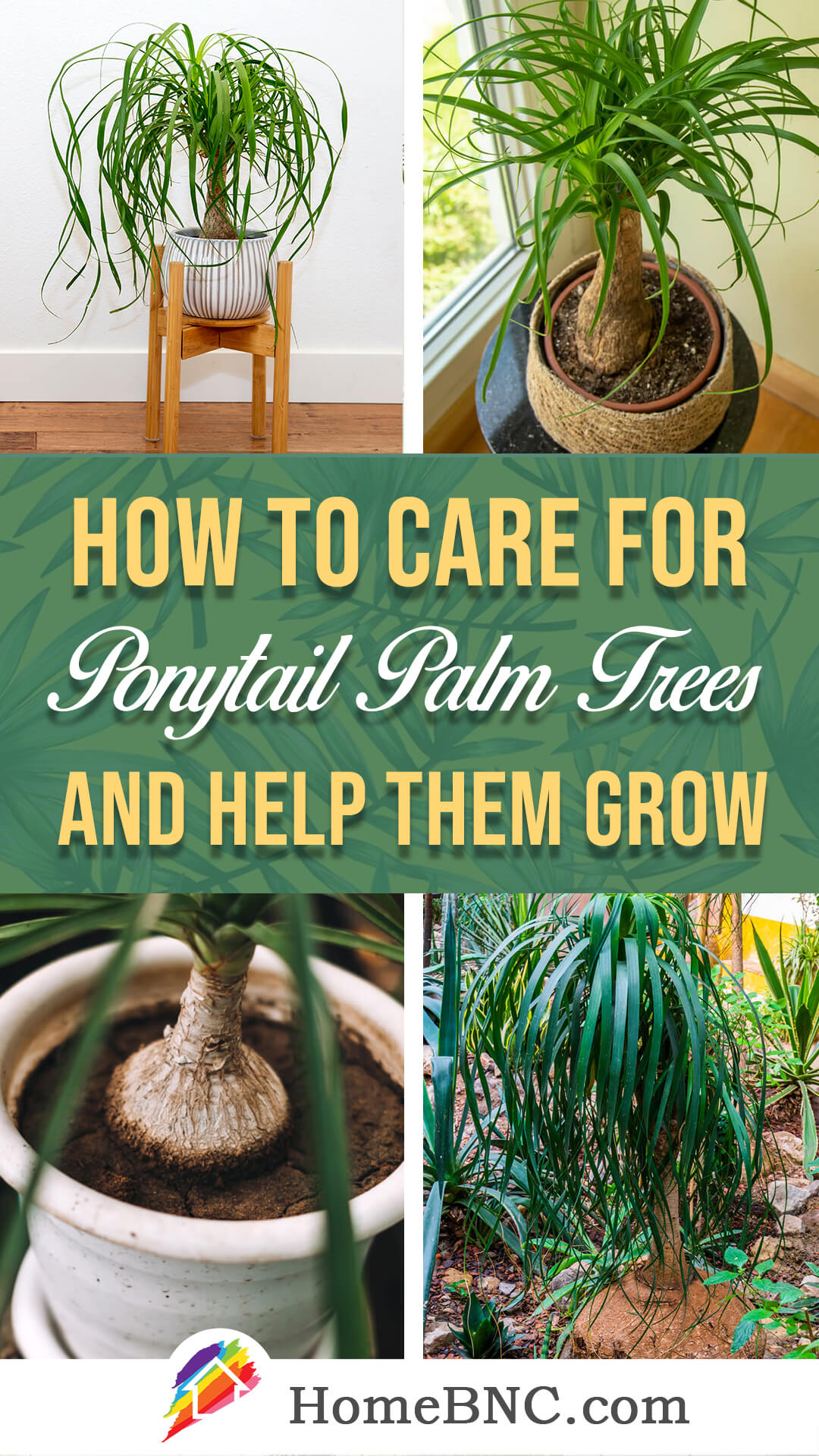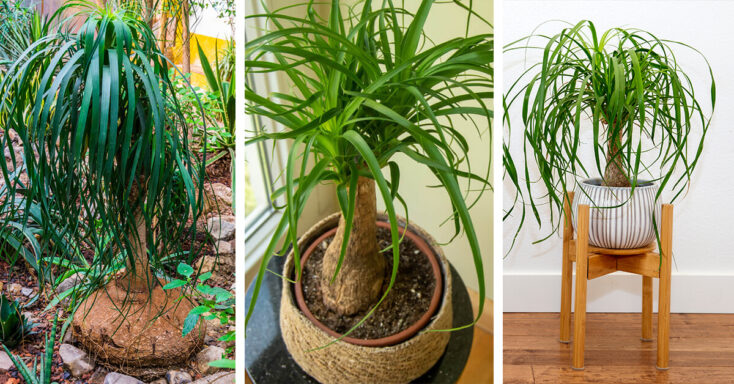The popularity of people growing “common” household plants like vines, jade plants, violets, and orchids is slipping just a bit. The day of unique and interesting ornamentals like the Ponytail Palm Tree has arrived. Homeowners want plants that command attention and encourage conversation. The good news is that growing ponytail palm trees and caring for them is fairly easy.
Ponytail Palm: A Case of Mistaken Identity
Ponytail palms have a secret: they’re not true palm trees. Rather they are part of the genus Beaucarnea (or Nolina), which has seven species. The plant was mistaken for a palm because of having one trunk and leaves posed on top.
The plants originate in Beliz, Mexico, and Guatemala in semi-desert regions. Ponytail Palms received their name because their leaves cascade much like the hair on a horse’s tail. They thrive in climate zones 9-10 and really aren’t fussy plants.
Alternative names for Ponytail Palm Trees include Elephant’s Foot Tree and Bottle Palm. Why Elephant’s Foot? The base looks swollen (sometimes 7’ across), so the shape appears a bit like an Elephant’s Foot. The leaves make a fantastic backdrop for creamy yellow flowers, blossoming in spring or summer. If you’re lucky, your Ponytail Palm Tree will blossom more than once a year.
Toxicity: unlike some other popular houseplants, Ponytail Palm is not toxic to pets or people. So you don’t have to look for a spot where kitty won’t hunt it down.
Key Takeaways
- Your Ponytail Palm benefits from occasional misting as it helps keep their leaves free of dust.
- While Ponytail Palms appreciate sunshine, they fare better in partial light where their fronds won’t burn.
- Overwatering often kills the Ponytail Palm, so be judicious about moisture.
- Only use fertilizer on your Ponytail Palm tree once or twice during the growing season. Overfeeding leads to curling and browning.
7 Prompts for Growing Ponytail Palms Indoors
1. Are There Different Types of Ponytail Palms?
This section comes under the heading of research before you buy. This palm tree is not cheap, so you want to figure out what’s best for your home. Even so, the overall care plan for your ponytail palm doesn’t vary. And, like any plant, each will have small quirks that you grow to know, love, and resolve.
- Guatemalan Red Ponytail: An undemanding houseplant. Its sculptural appeal adds to nearly any decor. The name comes from the plant’s twisted and reddish glossy leaves as they emerge.
- Beaucarnea Varigated: As the name implies, this particular ponytail palm has white to yellow stripes down the leaf’s side. For a while, these were rare, but cultivation improved their numbers dramatically.
- Golden Star Ponytail Palm: A striking change of pace from other ponytail species, the Gold Star’s leaves have streaks of yellow and chartreuse.
- Beaucarnea Gracilis: You can recognize this ponytail palm by its green-grey leaves, making them look almost blue.
- Beaucarnea Compacta: If you have limited space, this ponytail palm is destined for your home. These grow under 2 feet tall and 10 inches wide.
Growing Ponytail Palm is an exercise in patience. This tree doesn’t bloom until they’re about 10 years old, often much older. It’s exciting when the cream-colored flowers finally appear in the summer. The long wait for blossoms is one reason people may opt for an older plant. They simply don’t want to wait (and who can blame them)!
2. Mulling Over Your Decision to Grow a Ponytail Palm Tree
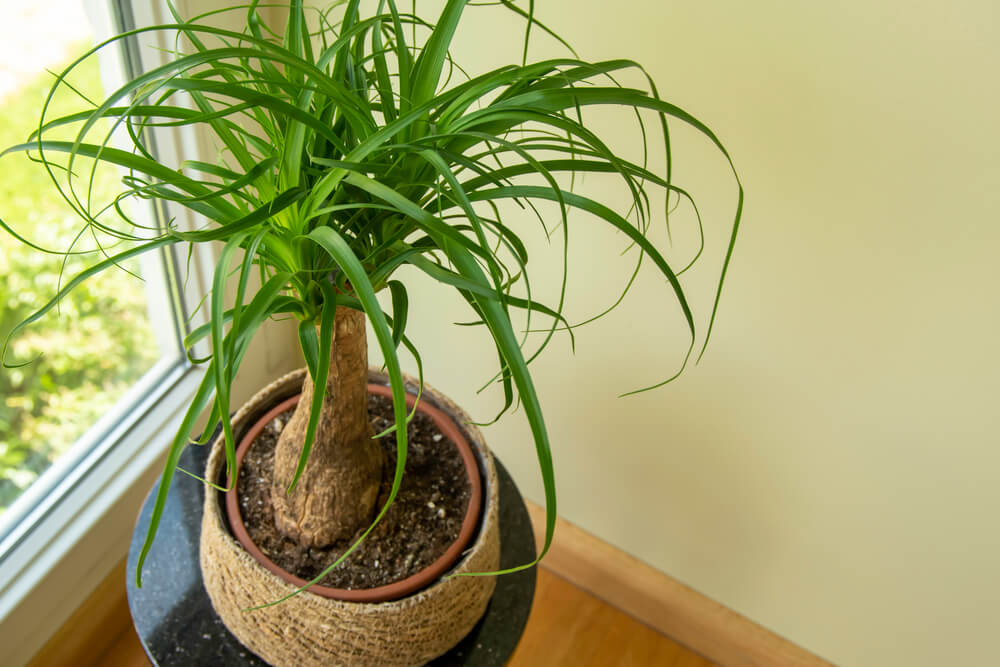
Before you buy a ponytail palm, inspect your home. First, think about space. No matter what type of palm you bring into your house, if you want to be happy, it needs a suitable place to “live.” You don’t want to have to step around it or wrangle the vacuum. While you can have a ponytail palm tree in a smaller residence, large, airy rooms are the best choice.
Speaking of which, do you have an area with bright light and some shade? You need to pick one out. If all you have is direct sun, is there a way to protect the plant with a curtain of some sort? Those fronds will get sunburned otherwise.
Next, is your home humid? Ponytail Palms get grumpy in dry conditions. Mind you, most homes don’t suffer from humidity swings. About 40% is ideal, and your house probably hovers around 30-50%. If the optimum can’t be reached naturally, go for the next best thing – a room humidifier that you can set and let it take care of the rest.
This palm acclimates quickly to a patio or porch. Are you considering giving your ponytail palm tree an outdoor vacation in summer?” Keep this in mind in terms of the size of the plant’s pot. The weight may make it impossible to move. Also, remember outdoor light is far more intense than indoor. Place your palm tree accordingly.
Keepin’ it Cozy
Your ponytail palm tree appreciates the security of a tight container. Choose a pot that’s no more than 2” wider than the plant’s base, with a drainage hole. You can add sand or small gravel to improve drainage. Remember that overwatering is the most common reason that ponytail palm trees die.
3. When to Plant
Take a cue from nature. Spring is the traditional time to plant a ponytail palm. But you can really plant it at any time of year since it’s indoors. Make sure the temperature in the house is over 45 F. Your best bet is propagating your palm from seed (which you can gather from another palm if you have one). Soak them overnight, then transfer them to a paper towel envelope. Put this in a warm area, and spray it with water lightly daily.
Leaf Ledger: The Ponytail palm has a domed stump that tapers off. At the top of the stem, rosettes of green, long leaves develop. Indoors, ponytail palm leaves may reach 3 feet long (outdoors, they’re twice that).
4. How to Set up Your Ponytail Palm for Success
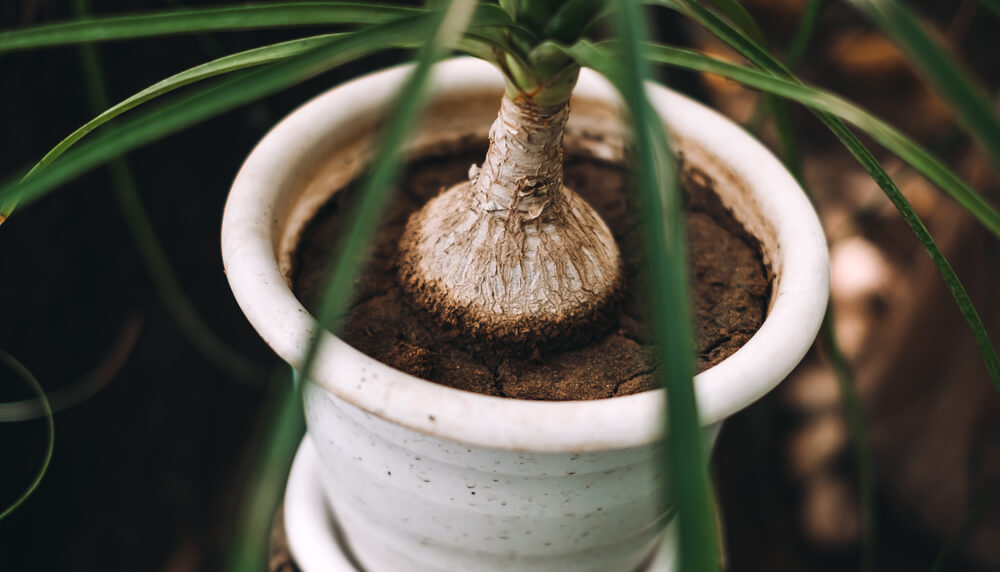
Begin with a shallow pot. The importance of a drainage hole cannot be overstressed. A palm sitting in wet soil for a while is prone to root rot. Clay pots are an excellent choice, often used for succulents and cacti).
In terms of soil, you can actually use a succulent potting mix. If you can’t find any, potting soil mixed with sand and perlite works (1 part per each). Fill the first ⅓ of the pot with your soil.
If you’re growing from a plant, release the roots gently. Place the root ball inside in such a way that any stem is about 1” below the top of the pot. Make sure not to cover the stem. Fill in the rest with soil.
Give the palm its first good watering. You want the soil evenly saturated (but not muddy). Put it in a partial-sun spot in your home, and let the soil dry out between waterings. The palm only needs fertilizer during flowering – once or twice a month.
Once established, your palm tree won’t need much but do watch for mealybugs and scale, two problems that affect ponytail palms.
Peeking into Ponytail Palm History
It was 1870 when the ponytail palm tree burst onto the botany stage. The French in Mexico discovered it, and they passed along the information to Europeans. From there, it became a globally appreciated ornamental plant.
5. Care, Keeping, and Repotting Ponytail Palms
The ponytail palm is one of those “set it and forget it” plants. It’s perfect for beginners. When placed in small containers, it will be many years before the tree requires repotting. Should you decide to repot, bear in mind the tree will grow accordingly.
Here are some tips for caring for your palm:
- Water where the stem and soil meet, not from above
- In your initial watering, soak the soil, let it drain, and dump any excessive water afterward. Afterward, let the soil dry between waterings.
- Cactus/succulent fertilizers are effective for ponytail palms.
- If you’re in a four-season environment, keep plants away from cold windows in winter.
Also, while handling your ponytail palm, be careful. They’re a little snappy, having minute serrated edges on the leaves.
Wintering
Because your palm is inside, you really don’t have to worry about wintering it. If you decide to follow the natural cycle for this plant, they take in more water in summer and go with larger dry periods in winter. You can put the palm in an area of about 50 F. During this time, your palm can focus on hardy root growth.
Sizing things Up: In Eastern Mexico, ponytail palms reach up to 30 feet high outdoors. Those grown in gardens usually top off at 10 feet. Your indoor plant? 4 feet.
6. Pruning Ponytail Palm
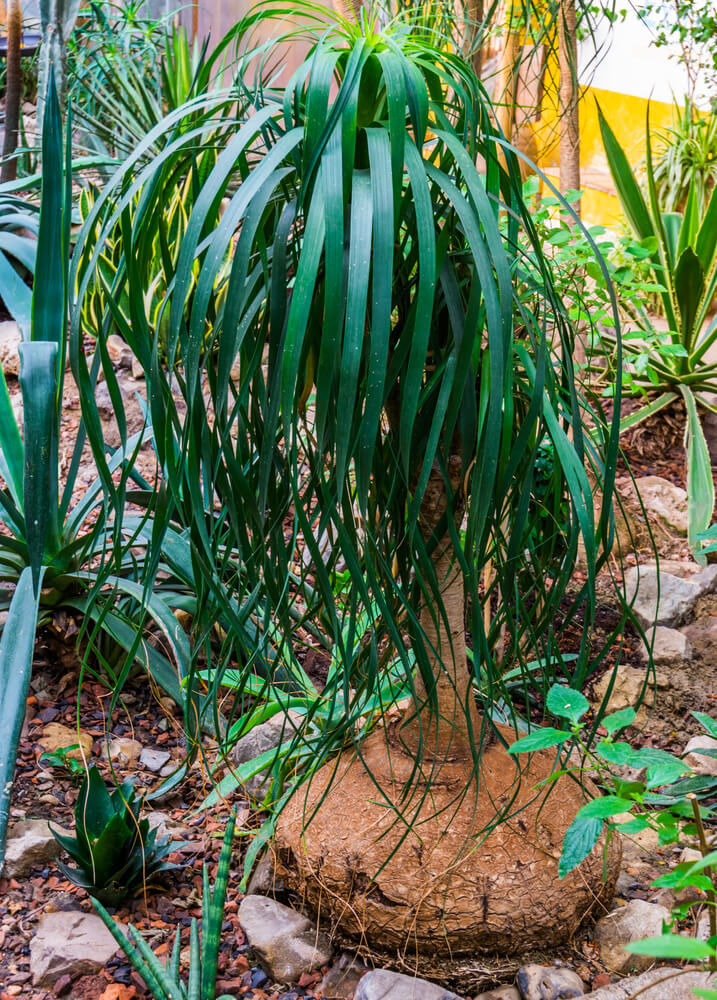
With the exception of minor tip browning, ponytail palms do not require pruning. Actually, over-pruning can hurt your tree. Leaving an open trunk exposes it to mildew and mold. If it starts rotting, it won’t produce leaves again.
By the way, if you notice browning foliage, this is a good time to check your plant. Is it getting too much sun? Are you under-watering? Both of these cause yellowing and browning as a leaf dries.
Not Just Another Pretty Face
The ponytail palm received the British Royal Horticultural Society the Award of Garden Merit. This award helps gardeners select the best-performing greenery. A plant receives the award on a trial basis for five years. Expert horticulturalists in specialty practices determine the outcome.
The factors considered in the award are:
- Excellent performance in appropriate conditions
- Good constitution
- Stability of form and color
- Pest and disease resistance
Additionally, the AGM has a rolling review, meaning plants must continue meeting the guidelines.
7. Ponytail Palm Tree – Wood Uses
The ponytail palm is neither soft nor hardwood. Common uses for it include
- Flooring
- Furniture
- Rafters
- Tool Hands
- Walking sticks
Symbolism: Ponytail Palms represent the pioneering, strong-willed spirit. Spiritually they’re an emblem of perseverance, resilience, and resourcefulness.
7 Powerful Approaches for Indoor Ponytail Palm Care
In Mexico, a record exists of Beaucarneas 350 years old. So your plant may well outlive you. You don’t really work with a ponytail palm as much as you sit back and enjoy looking at it. Prepare for 101 questions from visitors who have never seen indoor palms before. Hey, share this article with them!
Frequently Asked Questions About Growing Ponytail Palm Tree Care
How long do ponytail palms take to grow?
A lot depends on growing conditions. Outdoors in prime environments, they can grow 12 inches in one year. Indoors, however, it’s more like 2 inches a year. If you want to give your palm a boost, fertilize it in spring and summer, encouraging blossoms. When those appear, rejoice. The plant may have taken 30 years to reach this point.
How do I encourage my ponytail palm to grow?
No matter your temptation, don’t prune your ponytail palm. It will not encourage growth. The best approach to stimulating your plant is by sniping off the growing tip. It will re-sprout, and you’ll end up with little stems around the outside edge.
Do ponytail palms need full sun?
Ponytail palms truly love the sun, but they require indirect light. Too much sunlight can cause leaf burn. Near a south-facing window works best.
Do ponytail palms grow big?
Potted ponytail palms are slow growers. The pot size determines growth size. Expect leaves about 3 feet long. You can repot them, but you’ll end up with a larger indoor plant.
Why are ponytail palms so expensive?
As houseplants, ponytail palm trees have an exceedingly slow growth rate. So, taller ones are expensive. A 4-foot tall plant can cost an average of $250, give or take.
Is my ponytail palm male or female?
If the palms are in the flowering season, it’s easy to tell male from female. The female ponytail palm tree is pinkish, while the males are ivory.
